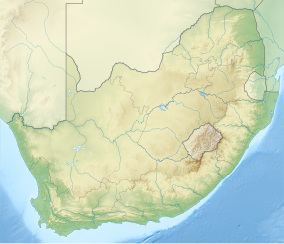Namaqua National Park
| Namaqua National Park | |
|---|---|
|
IUCN category II (national park)
|
|

Spring flowers in the N.P.
|
|
|
Location of the park
|
|
| Location | Northern Cape, South Africa |
| Nearest city | Kamieskroon |
| Coordinates | 30°2′36″S 17°35′10″E / 30.04333°S 17.58611°ECoordinates: 30°2′36″S 17°35′10″E / 30.04333°S 17.58611°E |
| Area | 700 km2 (270 sq mi) |
| Established | 1999 |
| Governing body | South African National Parks |
| http://www.sanparks.org/parks/namaqua/ | |
Namaqua National Park is a South African national park situated approximately 495 km north of Cape Town and 22 km northwest of Kamieskroon. It has an area of more than 700 km2. The park is part of Namaqualand, an area covering 55,000 km2 located within the semi-desert Succulent Karoo biome. This biome is a biodiversity hotspot with the largest concentration of succulent plants in the world. The park also has an arid environment with succulent plants. The park was created to protect its flowers. During the spring, wildflowers bloom there in a spectacular fashion. The park's main tourist attraction is this abundant spring bloom of brightly coloured wildflowers.
Namaqua National Park is located in Northern Cape Province, near South Africa's border with Namibia. The park is located approximately 495 km north of Cape Town and 22 km northwest of Kamieskroon. It was officially gazetted in August 1999. Skilpad Nature Reserve, formed in 1993 to protect Namaqualand's plant life, formed the nucleus of the new national park with the addition of 500 km² of land to create the park. 270 km² has since been added to the park, and it now has an area of more than 700 km². The park is semi-desert, with hot and dry summers and cold winters with variable, generally sparse rainfall. Most precipitation occurs between May and August. The eastern part of the park receives more rainfall than the west.
The park is part of the semi-desert Succulent Karoo biome, one of the most unusual biomes in the world. This biome is a biodiversity hotspot with the greatest biodiversity and the highest concentration of succulent plants of any of the world's arid regions. The biome has an area of about 107,200 km², stretching along South Africa's and southern Namibia's western coasts, and includes most of the Richtersveld. There are more than 5,000 plant species in this biome, including more than a third of all the succulent species in the world. Approximately 40% of the biome's plant species are endemic and 18% are threatened. The biome also has diverse invertebrate and reptile species, some of which are endemic. Illegal plant harvesting, overgrazing, and mining threaten endemic species. Only a very small percentage of the Succulent Karoo's area is formally protected, including the Knersvlakte Nature Reserve, the Richtersveld Community Conservancy, and Namaqua National Park.
...
Wikipedia

